APTA Annual Meeting Minutes
Back to Top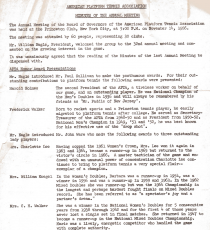
1966 Annual Meeting Minutes Only the first page of the Minutes have survived.
Read More

1966 Annual Meeting Minutes Only the first page of the Minutes have survived.
Read More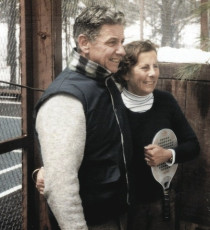
The WPPTA was formed in 1967 by five private clubs: The Edgeworth Club, Allegheny Country Club, Fox Chapel Racquet Club, Fox Chapel Golf Club, and the Rolling Rock Club. The purpose of the organization was to promote paddle to other clubs and organizations and to sponsor the Western Penn. Open tournaments, the first of which was held in 1968. Within four years women's., mixed, and junior tournaments had been added to the schedule. Source: Paddle Talk, Vol. 2, No. 1
Read More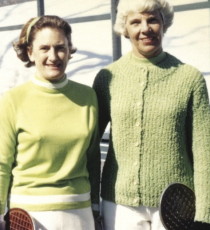
Gordon Gray and Jesse Sammis fell short again and were defeated by Bradley Drowne and William Scarlett. Charlotte Lee and Peggy Stanton1 repeated in the Women’s, as did Gordon Gray and Anne Symmers in the Mixed, and George Lowman and Bill Pardoe in the Men’s 50+. Cogswell's daughter, Do Deland, was a finalist in the Women's and his grandson, Rawle Deland, Jr., was the Junior Boy's finalist Source: Oliver H. Durrell The Official Guide to Platform Tennis, 1967; and APTA Platform Paddle Tennis 1963-1973: Rules and Records, 1973 Note 1: Margaret G. (“Peggy”) Stanton was a major contributor to the advancement of women’s platform tennis and a distinguished player. Besides winning the Women’s Nationals with Lee from 1967 through 1970, she went on to win two Senior Women’s Nationals in 1974 and 1977. She was the first female on the Board of Directors of the APTA [...]
Read MoreAmbassador Walter Stoessel, a keen player and lover of the game, introduced the game to Warsaw when he was appointed US Ambassador there in 1968. They had been initiated in the game at the Chevy Chase Club in Washington, D.C. and while they were far from expert they loved the game and thought it would be ideal in the long Polish winters. Using plans Supplied by APTA, they built a wooden court at the American Embassy in Warsaw. It worked, although it was quite a hybrid. The wood was obtained locally, the wire came from West Germany, and the lights were regular Warsaw street lights. The game caught on rapidly and was played enthusiastically by members of the American community in Warsaw and their friends in the foreign community. In 1970 he sent a letter to Paul Molloy, APTA President, enclosing a picture taken on February 20, 1970 before the inaugural game on the Warsaw Emba[...]
Read More
Oscar F. Moore served as President of the APTA from 1946-1948, which proved to be important growth years. He was credited with developing the mixed Scrambles or Jamboree, a format that gave the game much of its social overtones and proved to be very popular. Few people gave so much of their time and energy, or were so dedicated to platform tennis. (Fox Meadow Tennis Club).
Read More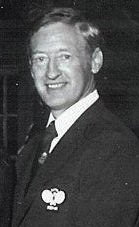
Malloy had been very close to the game for many years but, despite this, in his farewell remarks as President, he said, “….there is no way I can picture where our game will be 10 years from now. The instant appeal of the game is so great that it is impossible to estimate how long the accelerated growth will last and how far it will spread." Under his leadership the first newsletter was created to keep players informed of activities throughout the year and much work was done in scheduling and coordinating tournaments and satellite events in recognition of the new areas of growth in the game and their demand for tournament paddle. National rankings had also been established by the end of his term, with Hennessey donating cups to the individual man and woman gaining the most points from ranking tournament play. With the upsurge in women’s play, he was also instrumental in getting[...]
Read More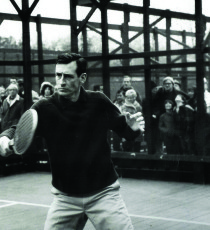
CBS had coverage of the National Mixed Doubles narrated by Heywood Halle Broun, Jr.
Read More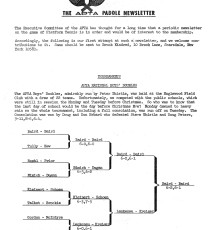
The newsletter leads off: “The Executive Committee of the APTA has thought for a long time that a periodic newsletter on the game of Platform Tennis is in order and would be of interest to the membership. Accordingly, the following is our first attempt at such a newsletter, and we welcome contributions to it. Same should be sent to Brook Kindred, 10 Brook Lane, Scarsdale, New York 10583.” The newsletter went on to cover the National Boys’ tournament (won by the Baird brothers) and the results of the Cleveland Invitational, Connecticut State Men’s, and Long Island Invitational. It also reprinted an article from the in-flight magazine American Way on paddle tennis. The newsletter was edited by Fox Meadow member, Brook Kindred for four years
Read MoreThe foot-fault revision was unofficially known as the “Kimberly Rule,” after Kim Kimberly who took a running leap at the ball, ignoring the baseline and violating most rules, however modified. He was fun to watch though! The First APTA newsletter carried a discussion on foot-faults and the let rule if a ball was bounced out of the court. "Foot-Faults At a recent meeting of the Executive Committee, the foot fault rule was discussed ad infinitum due to the flagrant violation of it by numerous players who are beating their serve to the net. To reiterate, the APTA foot-fault rule is a direct copy of' the USLTA rule: The server shall throughout the delivery of' the serve: A. Not change his position by walking or running. B. Not touch, with either foot, any area other than that behind the baseline within the imaginary extension of' the center mark or sideline. Section A w[...]
Read More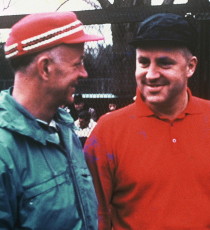
George R. Harrison won the Men's Nationals in 1956 and 1960 and the Men's 45+ in 1963. He was active in the APTA as chairman of the Rules and Equipment Committee and, during his tenure and through his efforts, the yellow-orange ball that replaced the original white ball was introduced and became the ball standard until the modern yellow ball was adopted. (Fox Meadow Tennis Club). William E. Pardoe won the Men's Nationals in 1956 and 1960, the Mixed Nationals in 1965. and the Men’s 50+ three straight times (1966-1968). He had one of the all-time best serves in the game, and brought the American twist service to platform tennis. (Fox Meadow Tennis Club).
Read More